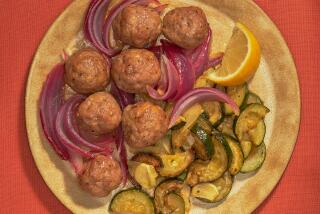Produce That’s Easy to Swallow : With a little innovation, lots of fruits and vegetables can be incorporated into diets, nutritionists say.
- Share via
Does the thought of choking down five servings of fruits and vegetables a day makes you want to bolt from the produce department?
While medical research suggests that five servings or more a day will reduce the risk of developing heart disease and many kinds of cancer, loading up a dinner plate with green beans and beets and zucchini still doesn’t come naturally to many people.
Most Americans eat only 3 1/2 servings a day, and more than 40% eat two or fewer fruits and vegetables daily, according to a 1991 survey conducted by the Produce for Better Health Foundation and the National Cancer Institute.
But, say nutritionists, it is possible to incorporate lots of fruits and vegetables into your diet--and actually enjoy them.
“Five a day isn’t that much,” says dietitian Lisa Licavoli, owner of Newport Beach-based Concepts in Nutrition. “If you accompany your breakfast with a piece of fruit, have a large salad for lunch and vegetables and fruit with dinner, you’ve met your goal.”
Here are some ways nutritionists suggest to make fruits and vegetables easier to swallow:
Vary selections
Not only will choosing different types of fruits and vegetables keep you from getting bored, but also eating a wide variety is a healthy thing to do. Although researchers have found that certain nutrients such as beta-carotene (a form of Vitamin A) are useful in fighting cancer and aging, they’ve come to the conclusion that no one vitamin can be singled out; they all work together.
It’s important that you eat many different types of fruits and vegetables, which shouldn’t be hard in Southern California. Stores here carry a wide selection of high-quality common and more exotic produce.
Keep serving sizes in mind
Guidelines say a serving equals one cup uncooked fruit or vegetables or half a cup cooked. Some nutrition experts such as Eileen Saitowitz, an Irvine-based certified nutrition consultant, prefer to err on the positive side and consider all servings one cup. Usually, a large vegetable or piece of fruit equals one serving.
Start the day off right
Get one serving in as soon as you wake up by eating fruit with breakfast. Put bananas or berries on fat-free cereal, oat bran or oatmeal, Saitowitz says.
Or, if you prefer something liquid in the early hours, shakes are another good choice. Mix berries or bananas with tofu and nonfat milk and you’ll have a healthy, high-protein shake to give you energy for the day ahead.
You can also drink fruit juice in the morning, but don’t overdo it, Licavoli says. “Although fruit juices have valuable nutrients, the fiber has been removed and they are high in sugar. It’s best to eat the whole fruit whenever possible.”
Prepare innovative lunches
Lunchtime provides a good opportunity for eating fruits and vegetables. When making sandwiches, pile on onions, tomatoes, lettuce and bean sprouts. There are a number of creative sandwiches you can make that don’t require meat.
“Put one or two teaspoons of peanut butter in a pita and add sliced banana,” Saitowitz says. “This gives you a complete protein lunch with one serving of fruit.”
Or, she suggests, try an avocado, tomato and bean sprout combination. “Although the avocado is high in fat, if you use it sparingly (one tablespoon), it’s a healthy part of any diet,” says Saitowitz. Another tasty sandwich is cucumber, tomato and a little cheese.
If it is salads you like, use Romaine or another really green leafy lettuce (iceberg has virtually no nutritional value), and pile it high with an assortment of vegetables. Besides the usual (such as tomatoes and cucumbers), try adding high-fiber navy beans and garbanzos, or crunchy jicama.
Soup is another good lunch item. “There are a few nutritious soups on the market, like Health Valley’s Chunky Five Bean Vegetable Soup,” says Saitowitz. Or make your own. She coarsely chops such vegetables as onion, carrots, parsnips, turnips, celery, pumpkin, zucchini and potatoes and cooks them in water with low-salt or unsalted bouillon and some tomato sauce. Simmer until the vegetables soften and then add fresh herbs, such as dill.
Add sauces
There’s no need to bore yourself with plain vegetables, says Licavoli. “Although they often have a little oil, salt and/or sugar, sauces are fine to use in moderation if they enable you to eat your vegetables. In other countries where people consume more vegetables, they use many pungent sauces made from things like soy, teriyaki, sesame oil, peanut butter sauce, flavored vinegars, ginger, garlic and cayenne.”
You can buy a variety of sauces, or make your own. Licavoli makes a curry ginger sauce with one cup plain nonfat yogurt; one tablespoon curry powder; 1/2 teaspoon powdered ginger; one green onion and a pinch of sugar and salt to taste. Or make a mustard sauce with one tablespoon olive oil; one teaspoon Dijon mustard and two tablespoons flavored vinegar.
For salads and vegetables, you might make a poppy seed orange vinaigrette, which calls for one-third cup olive oil; one-fourth cup fresh squeezed orange with one tablespoon grated orange peel; one tablespoon poppy seeds and a pinch of sugar, salt and freshly ground black pepper to taste.
Increase ratio of vegetables
It’s not that difficult to make vegetables the focus of a meal. When you make a stir-fry, instead of adding as much meat as the recipe calls for, try cutting the meat by half or more and making up the difference with vegetables.
Mexican dishes offer a lot of opportunity to add vegetables. “Make tacos, tostadas and fajitas by using meat sparingly and adding a lot of vegetables like romaine lettuce, tomatoes, onions, mushrooms and bell peppers,” says Licavoli.
Try meatless dishes
While it’s not necessary to become vegetarian, experts do suggest that you eat some meatless main meals each week. At first this may sound limiting, but there are many tasty vegetable-based dishes.
Just about any vegetable is great stir-fried, including eggplant. Saitowitz suggests sauteing this with onion in a little olive oil, or for a unique taste, stir-fry carrots, zucchini and garlic. Also good stir-fried are Roma tomatoes, garlic and basil. All of these can be placed on pasta or rice and topped with a little fresh Parmesan cheese.
Make old favorites with vegetables instead of meat. Steam vegetables and place them on pasta with spaghetti sauce or make vegetable lasagna with low-fat cheese. You might try vegetable pizza topped with such items as grilled eggplant, mushrooms, sun-dried tomatoes, spinach, peppers and pineapple.
A quick and filling meal is a baked potato stuffed with steamed broccoli and topped with a little cheese or nonfat cottage cheese.
Feed your sweet tooth with fruit
For a flavorful, good-for-you dessert, Licavoli suggests baked apples. Core, but don’t peel, Rome apples and dust the insides with cloves, cinnamon, a little brown sugar and a drop of vanilla. Bake them uncovered at 350 degrees in a half-inch of water for 45 minutes to an hour, until tender. Baked pears are good, too. Cut them in half and remove their seeds; dust fruit with cinnamon and cloves, then place them skin-side down in half an inch of water and add a drop of almond extract. Baste with the liquid and cook for about 30 minutes in a 350-degree oven.
Other good fruit desserts include dried fruit, berries topped with frozen yogurt and frozen bananas on a stick.
More to Read
Eat your way across L.A.
Get our weekly Tasting Notes newsletter for reviews, news and more.
You may occasionally receive promotional content from the Los Angeles Times.










